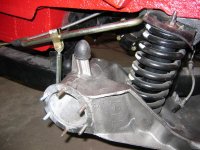I'm reaching out to anyone who might know the answer to a question I have concerning trailing arms: Did the geometry of the trailing arms on late TR6's change from the trailing arms on TR250's and early TR6's?
The reason I'm asking is I am trying to figure out why my TR250 sags to the left. Before everyone chimes in with suggestions of checking for worn springs, bushings, cracked spring tower, loose shocks, improperly mounted trailing arm brackets or rusted frame, know that I have new Goodparts springs all around, adjustable Goodparts brackets, fairly new shocks and links, new polyurethane bushings, no cracks in springs tower and a solid frame that is square- I personally checked out the frame this past weekend with the car up on jacks and using a plumb bob in order to check for squareness and all is good, except, except that one point (point D, left side, for those of you who are familiar with the frame diagram in the blue Bentley manual) is 5/16" higher than the right side.
My reason for zeroing in on the trailing arms is that the T/A's on my car are from a late TR6, Stanpart # 308224 & 308225. I have read in Roger Williams book "How to Restore Triumph TR5/250 & TR6" 2003 (page 134, 1st column) that "...it's not generally appreciated that at the same time as the mounting bracket 'notches' were changed, a change occurred to the trailing arms, and the angles varied from earlier castings. This can be another reason why some home restorers have difficulty re-establishing rear suspension geometry."
I have spoken to some very knowledgeable people who are very sure no change in geometry took place, but because of these two sentences in a book written by an widely accepted expert, I'm wondering who is right. Can anyone out there say with certainty that the geometry changed, or did not change, in the years between 1968 and 1976?
Dave Arbour
Augusta, Maine
The reason I'm asking is I am trying to figure out why my TR250 sags to the left. Before everyone chimes in with suggestions of checking for worn springs, bushings, cracked spring tower, loose shocks, improperly mounted trailing arm brackets or rusted frame, know that I have new Goodparts springs all around, adjustable Goodparts brackets, fairly new shocks and links, new polyurethane bushings, no cracks in springs tower and a solid frame that is square- I personally checked out the frame this past weekend with the car up on jacks and using a plumb bob in order to check for squareness and all is good, except, except that one point (point D, left side, for those of you who are familiar with the frame diagram in the blue Bentley manual) is 5/16" higher than the right side.
My reason for zeroing in on the trailing arms is that the T/A's on my car are from a late TR6, Stanpart # 308224 & 308225. I have read in Roger Williams book "How to Restore Triumph TR5/250 & TR6" 2003 (page 134, 1st column) that "...it's not generally appreciated that at the same time as the mounting bracket 'notches' were changed, a change occurred to the trailing arms, and the angles varied from earlier castings. This can be another reason why some home restorers have difficulty re-establishing rear suspension geometry."
I have spoken to some very knowledgeable people who are very sure no change in geometry took place, but because of these two sentences in a book written by an widely accepted expert, I'm wondering who is right. Can anyone out there say with certainty that the geometry changed, or did not change, in the years between 1968 and 1976?
Dave Arbour
Augusta, Maine

 Hi Guest!
Hi Guest!

 smilie in place of the real @
smilie in place of the real @
 Pretty Please - add it to our Events forum(s) and add to the calendar! >>
Pretty Please - add it to our Events forum(s) and add to the calendar! >> 

